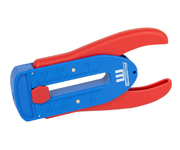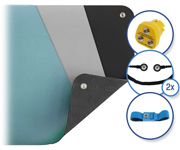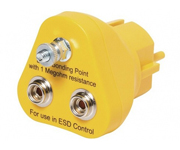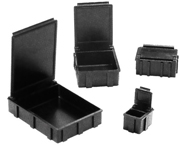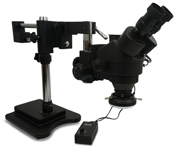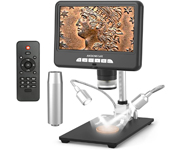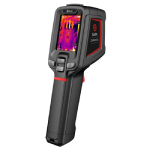On the oscilloscope or spectrum analyser, the signal to be measured is often transferred via a coaxial cable. They come in many different types and sizes. Therefore they have different properties that can limit the measurement or the way it is used. Therefore, it makes sense to pay attention to the type of cable when buying.
Which one do you need? The more common types are outlined below.

An N-male - N-male coaxial cable of type RG-223.
Anatomy of a coaxial cable
There are a few properties that apply to all coaxial cables.
The main factors influencing the properties of the cable include:
- length
- diameter copper
- diameter isolation
- type of isolation
- connectors
- impedance
Impedance and attenuation
In the context of measuring equipment, impedance refers to the internal impedance of the measuring equipment. This is often written around the terminal of the measuring equipment and is usually 50 Ω.
Variable signals often contain different frequencies. These frequencies can be sensed differently depending on, among other factors, the impedance of the cable. The higher the frequency, the easier it is for the signal to get erroneous. This has to do with the fact that starting at a given frequency the cable behaves more like a transmission line than a direct connection. The underlying theory proves that the side effects of a transmission line can be remedied to some extent by using the same impedance cable as the input impedance of the measuring device.
The impedance of a coaxial cable is not always (clearly) stated on the cable. Keep cables with different impedances apart. Not necessarily because of a distorted input signal, but also because a cable with a different impedance can sometimes have slightly different connector dimensions. This may damage the measuring equipment.
Furthermore, it is good to know that when a measured signal travels through the cable, not all frequencies arrive at the same level. Especially at higher frequencies this matters. How much certain frequencies exactly are attenuated can often be found in the datasheet of the cable which can often be downloaded from the manufacturer's website.
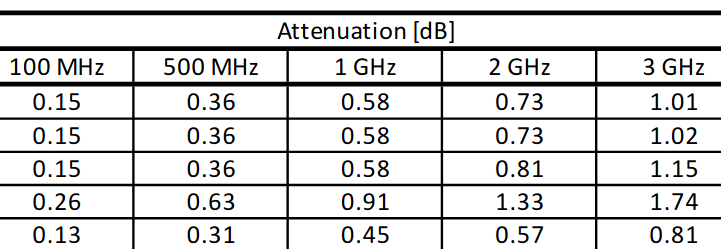
Example of a datasheet with different types of cables under each other. Not every frequency is attenuated equally, some cable types do a better job than others.
Connectors
A cable can only be used if the connections correspond to the devices to be used. However, there is a reason why different connections exist, as each has its advantages and disadvantages.

Different types of connections (not to scale). From left to right: BNC, SMA, Type-N, SMB.
BNC
The BNC connector is one of the most popular connections on measuring equipment, especially on oscilloscopes and function generators. It is robust and suitable for most practical measurements. Often used for frequencies <4 GHz. The latter makes it slightly less suitable for RF measurements. Equipment for higher frequencies often uses Type-N (see below), or otherwise, a custom-made connector.
SMA
SMA connectors are smaller and can transmit very high frequencies. That is why you find them often on radio devices such as Bluetooth dongles and WiFi boxes. Many RF dongles (the RTL-SDR comes to mind) use these ports for their antenna connection.
Type-N
Type-N, often N-type or N for short, is also a common connector. This connector is quite robust and can withstand high power. The connector also has a wide frequency range. These features make this connector a popular connector to use on spectrum analysers.
SMB
SMB is not common in practice, but it is still a relevant, handy connector. SMB differs from the other connector types in that it is much smaller than SMA and does not have a screw mechanism. It is therefore often used in extensively modular equipment to plug one component into another without hassle. The bandwidth is approximately the same as that of BNCs.
Common cable types
In earlier times, the military defined a series of cable types in the so-called "Radio Guide", in short RG. Many of these types are still used in labs today. Below are listed the most common types.
RG-58
The most widely used type of coax cable because of its attractive price.
RG-223
Comparable to the RG-58, but it has much improved shielding.
RG-142
Tougher cable for even higher power transmissions and higher bandwidths.
RG-213
The thickest cable we offer, but also has the lowest loss at higher frequencies. Therefore extremely suitable for radio applications and EMC test rigs. For longer cables, this is a must.
RG-316
In some setups, different devices often need to be connected. To facilitate this, RG-316 cables are very suitable: they bend very easily and have connectors that last longer than those of other types of cables. However, it's important to note that RG-316 cables also have the highest amount of signal loss compared to other cable types.
Comparison table
| Coax type | RG-58 | RG-142 | RG-213 | RG-223 | RG-316 |
|---|---|---|---|---|---|
| Impedance | 50 ± 2 Ω | 50 ± 2 Ω | 50 ± 2 Ω | 50 ± 2 Ω | 50 ± 2 Ω |
| Bendability | + | - | - - | + | + + + |
| Outer diameter (mm) | 5 | 4.95 | 10.3 | 5.4 | 2.6 |
| Max power @ 1 GHz | 65 W | 380 W | 416 W | 80 W | 135 W |
| Frequency range | 5.8 GHz | 6 GHz | 3 GHz | 6 GHz | 6 GHz |
| EM shielding (avg.) | + | + + + | + | + + + | + |
| Price | € | € € € € € | € € € | € € | € € |
Over at Wikipedia you can find a more exhaustive list of cable types.
BUY YOUR COAX CABLES AND ACCESSORIES HERE
Which coax cable do I need?
First check carefully which type of connections your equipment needs. Oscilloscopes and function generators often use BNC, whereas spectrum analysers often use Type-N. Smaller and RF-related products often use SMA.
The impedance of your equipment is important for the most correct transmission of the measured signal. In most cases this is 50 Ω but some equipment uses 75.
In terms of cable type you have more freedom of choice. The RG-58 is the cheapest cable while equally being suitable for most applications.
If your budget allows for, we recommend the RG-223. It is an excellent cable with double shielding properties and permits higher power measurements.
In case the maximum power is a limiting factor consider the RG-213. If high power throughput is needed in combination with high bandwidth, use the RG-142. For cables longer than >5 meters there is no other choice but the RG-142, for it excels in most specifications. However, it is a bit on the expensive side.
For shorter connections, see if you can use the RG-316. This one is very short and flexible which makes it easier to connect measuring equipment in a compact way.







